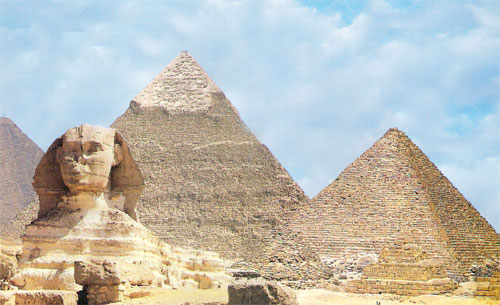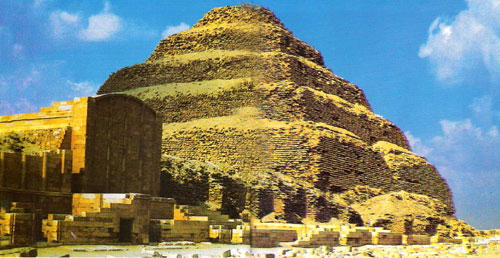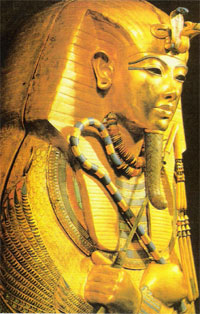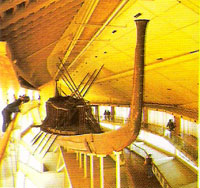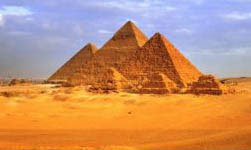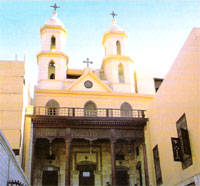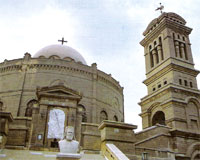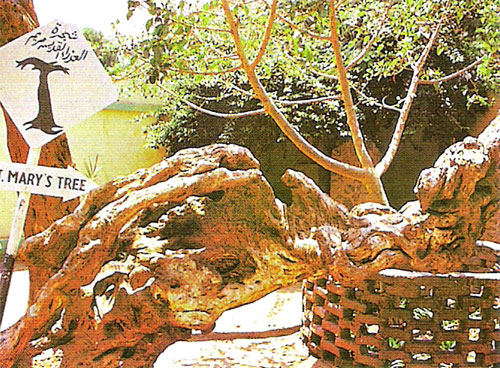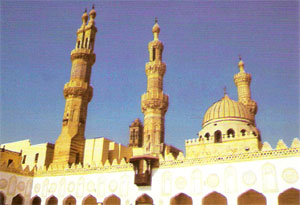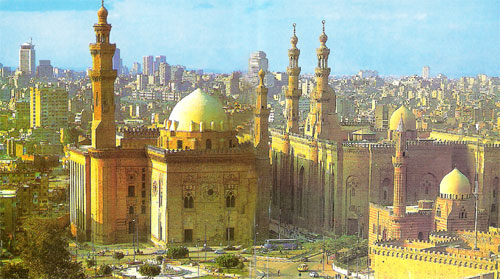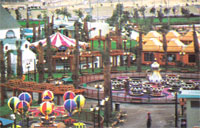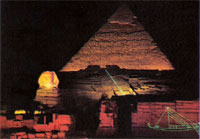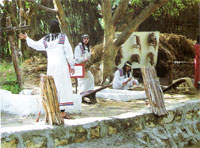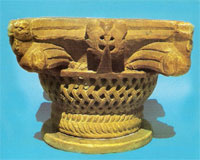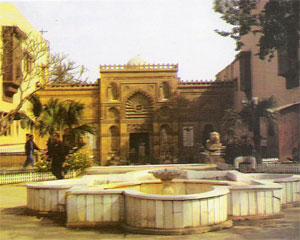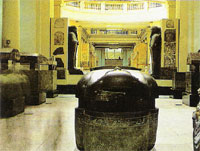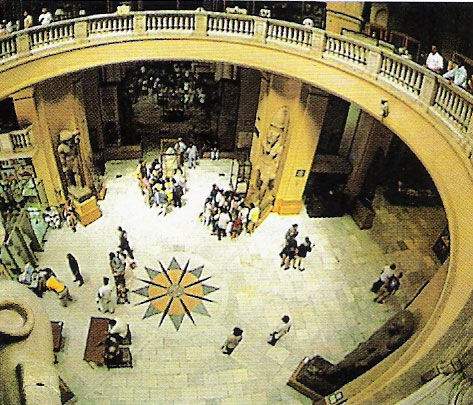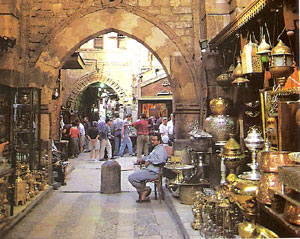As ancient as history itself, Cairo occupies a singular place among world cities, with a geographical position so unique that an interchange of influence with the civilizations to which it stood witness was made possible. In fact Cairo could be the world's only city with monuments dating back to four different historical periods-the Pharaonic, the Roman, the Christian and the Islamic.
Thus, alongside the ancient city, revelling in the old glories, there stands modern Cairo, witness of the enormous progress by Egyptian hands.
The colossal statue of Ramses II., exhibited in the museum. This is the most beautiful representation of Ramses II. It is made of fine-grained limestone, 13 metres long, and weighs 120 tons.
The Temple for Embalming the Sacred Apis Bull, which shows the various steps of embalming.
The Alabaster Sphinx of King Tuthmosis III.
Saqqara
Saqqara is the oldest Ancient Egyptian cemetery. It lies on a desert plateau, south-west of Cairo. Above rises the step-pyramid and mortuary compound, built by the engineer Imhotep for King Zoser the first of the III Dynasty pharaohs. It is of the mastaba-type. The pyramid is composed of six receding mastabas on top of each other. The later pyramid builders developed this concept into the familiar even-sided pyramids. The step-pyramids measures 123.5 by 107 ms, at the base and about 59 ms in height.
Important Sights of Saqqara
The Pyramid of Unas
South of the Step-Pyramid, lies the Pyramid of Unas, last of the V Dynasty pharaohs. This pyramid is noted for its tomb chamber, whose walls are inscribed with what is known as the "Pyramid Texts", and whose ceiling is decorated with stars that seem to sparkle above the royal mummy.
Near to the Pyramid of Unas lies the Persian Shaft, a tomb of XXVI Dynasty known as the "Persian Dynasty" The Shaft is 25 ms deep and at the bottom lie several tomb chambers.
The Mastabas
Saqqara is noted for the mastaba-type tombs of the nobles, the most prominent of which are the tombs of V and Vl Dynasty nobles. The tomb walls bear inscriptions showing the daily life of Ancient Egyptians, such as: farming, animal breeding, hunting, as well as religious rites and the offering of sacrifice to the dead.
The most important mastaba tombs of the nobles are
The Mastaba of Ptah-Hotep
Lies south-west of the Step- Pyramid and contains numerous mural paintings and inscriptions portraying daily, religious and funerary rites, as well as religious texts. The most important scene shows Ptah-Hotep a renowned Pharaonic philosopher- being entertained by a band of musicians.
The Mastaba of Kagemni
This tomb is noted for its mural reliefs especially the scene of bird hunting.
The Mastaba of Mereruka
Contains 33 chambers, the walls of which are filled with inscriptions portraying scenes from daily life, farming handicrafts, hunting. One important scene shows the veterinary treatment of animals.
The Serapeum
Only the lower corridors remain, measuring several hundred metres, in length, and containing the tombs of the sacred bull, Apis . It was first begun by the XVI I Dynasty. Close to the Serapeum lies the Greek Philosophers Circle, which contains statues of Plato, Heraklites, Pythagorean and Pindar.
The Pyramids of Giza
They are situated about 10 kms from Cairo, and comprise:
The Great Pyramid
The most famous structure in the world was built by King Cheops (IV Dynasty) around 2650 B.C., on an area of 13 feddans. Its height now is 137 ms (original height: 146 ms). Almost 2.5 million blocks of stone were put into building this pyramid, which measures 230 ms square at the base. All this, however, dwindles when compared to the precision and astounding ability of the ancient Egyptian in building this pyramid. Close to the eastern flank of the Pyramid of Cheops lie three small pyramids dedicated either to his wives or family members.
The Second Pyramid
Built by Kephren, south-west of his father's pyramid though lower in height: 136 ms, it still retains, on some of its upper parts, the remains of the limestone that had once covered it all. At the base, it measures 215.5 ms square. Its interior is simple, with two entrances on the north side. The Second Pyramid, like all other pyramids, had an exterior covering of fine-grain limestone. Now, only a small part of this covering remains.
The visitor can also still see the remains of his mortuary temple, the Temple of the Valley, and rising causeway. These temples witnessed the religious rites during the embalming of the body.
The Third Pyramid
Built by Mycerinus (Menkaure), south-west of the Great and Second Pyramids. It is much smaller than either one (62 ms). It is distinguished by the fact that the lower part of its sides still retain their granite slab coverings.
The Ancient Egyptians, it must be noted, built the pyramids to be tombs to preserve the bodies of their dead kings, especially that they believed in resurrection and immortality . The three Pyramids of Giza are surrounded by several small pyramids, and hundreds of mastaba-tombs of the royal family, nobles and high-ranking people.
The Solar Boats (The Boats of Cheops)
The Ancient Egyptians carved spacious areas in the rock, near the Pyramids. There they placed wooden boats, to be at the disposal of the King when he went on his journey of Day and Night with the sun god, Ra, in the after world.
Early excavations have discovered three such sun boat sites, on the east side of the Great Pyramid. Two other sites were discovered on the south side. When the huge stone slabs were removed, they revealed parts of a large boat, made of cedar wood, in very good condition. There were also other implements, such as oars, ropes and a kiosk for sitting. The boat was 43.5 ms long, the prow and stern were 5 ms and 7 ms high respectively. The boats are now housed in a special museum, south of the Pyramid of Cheops. The museum is open from 9-4 daily, for a fixed fee.
The Sphinx
On the way to the Temple of the Valley, (of the pyramid of Kephren), lies the large statue of the Sphinx. It is one of most famous monuments in the whole world. It is, indeed, a legendary statue for it has the body of lion and the face of a man. It is 70 ms long and 20 ms high.
Scholars and scientists are of the opinion that the face of the Sphinx closely resembles that of King Kephren. The Sphinx, and the Three Pyramids, are regarded as one of the Seven Wonders of the World. A small fee is to be paid when visiting the Pyramids area.
Christian Monuments
Most of the old churches are located in the Old City on the ruins of the Fortress of Babylon.
AL-Kaneesah Al-Mu'allaqah Church (Hanging Church)
Dating to the late 4th and early 5th Century, this basilica was named "Al-Mu'allaqah" because it was built on top of the south gate of the Fortress of Babylon.
Church of Abu Sergah (Church of St. Sergius)
Dating back to the beginning of the 5th Century, this basilica is built on the cave in which the Holy Family stayed and is regarded by visitors as a source of blessing.
Church of Sitt Barbara (Church of St. Barbara)
Founded in the 5th Century, it was rebuilt in-the 10th C. and still retains its wooden door which constitutes a magnificent example of fine art.
Church of St. Mina
Located in the Old City, it was built in the 6th Century AD.
Church of Al-A'dra (Church of Virgin Mary)
Dating back to the 8th Century, this church contains some precious icons and has three haykals behind ivory-inlaid wooden screens.
Church of Virgin Mary in Zaytoun This church gained special significance after the appearance of the Apparition of the Virgin above one of its domes.
The Cathedral of St. Mark
This, the largest church in Africa, was built recently in Abbassia and reflects the evolution of the art of architecture. The remains of St. . Mark, the first to preach Christianity in Egypt, were moved to this Cathedral.
Church of Marie Guirgis (Church of St. George)
Built on the ruins of an ancient church, this basilica has a unique hall dating to the 3rd Century AD. The Virgin's Tree This is the tree where the Virgin rested with the Child Jesus when they came to Egypt.
Islamic Monuments
Mosque of Amr lbn Al-'Aas (Al-Fustat)
It was the first mosque built in Egypt. It is simple in design and represents schools of architecture from different periods . Mosque of Ahmed Ibn Tuloun The third mosque built in Egypt, it is characterized by its spacious grounds and its unique minaret, spiral, and a large collection of gypsum decoration.
Al-Azhar Mosque
The first Fatimid mosque in Cairo, it was founded in Midan Hussein by Gawhar al-Sikilli in 971 AD (361 H) as both a mosque and Madrasah (school), after Fatma al-Zahraa, the daughter of the Prophet Mohammed. It is considered to be the oldest Islamic University, the first lecture having been delivered in 975 AD.
Mosque of Al-Mu'ayid
Located in Al Mu'ez St., Gammaleya, it was built in 1474 AD (823 H), its minaret rising above one of the City gates built in 1091 AD. Mosque and Madrasah of Sultan Hassan Located at the end of Al-Qala' (citadel) St., it was founded by Al-Malek Al-Nasser Hassan Bin Mohammed Ibn Qalawon to be a mosque and madrasah for the four schools .
The Blue Mosque
Located in Tibbanah Street, it was founded by Prince Aqsunqur Al-Nassery in 1347 AD. It was so named because of the splendid blue mosaic on its walls.
The Alabaster Mosque (Mosque of Mohammed Ali)
It was built in 1830 AD (1246 H) on the northern elevated part of the Citadel, visible to all parts of Cairo. It was so named because its walls are faced with alabaster on both sides.
Other Islamic Monuments
Fortress of Salah al-Din al-Ayyubi (The Citadel)
Built by Salah al-Din al-Ayyubi in 1183 AD overlooking the city of Cairo from the Muqattam Hills, it houses a number of important monuments including the Mosque of Soliman Pasha, the Alabaster Mosque, the 90-meter deep Bir Yusuf (Joseph's Well) and Al-Gawhara Palace.
House of Al-Seheimi
Located in Darb al-Asfar, it was founded in 1796 and constitutes another example of Islamic architecture.
House of Gamal al-Din al-Dhahabi
Located in Al-Ghoureya, it is an example of Arab buildings of the early 17th Century AD.
Attractions of Modern Cairo
National Cultural Center (Opera House)
The new 7-story opera house at the Gezira Exhibition Grounds was inaugurated on 3.10. 1988. Designed by a team of Japanese and Egyptian architects, it is an architectural masterpiece of Islamic design. It is equipped with the most sophisticated audio-visual system and comprises:
The Main Theater, a closed hall comprising 1200 seats, is used for opera, ballet and classic music performances .
The Second Theater is also a closed hall comprising 500 seats and is used for various purposes including film festivals and conferences.
The Third Theater is an open one comprising 1000 seats. There are other halls, some of which are used for training and rehearsals, in addition to the Museum and the Library containing references pertaining to the most significant artistic works.
Cairo International Center for Conferences ( CIIC )
Located in Nasr City, it comprises three main conference halls, a fourth for receptions and a fifth for exhibitions. In addition, there are fully-equipped secretarial offices and press center.
- Main Hall: 2,500 sq.m., 2,500 seats.
- Second Hall: 840 sq.m., 800 seats.
-Third Hall: 900 sq.m., 600 seats.
-Receptions Hall: 1,600 sq.m.,1,250 seats.
-Exhibition Hall: 2,500 sq.m.
For information Tel. (202)2634637
Fax. 2634640
Cairo Tower (Gezirah)
Over 180 meters high, it is the most outstanding attraction of modern Cairo. The first of the top two stories has a rotating restaurant and cafeteria. Visitors can enjoy a panoramic view of Cairo from the observation platform.
Sound and Light Show
In an enchanting atmosphere, with sound, light, and music, the show captivates audiences and makes re-live ancient times, the history of the Pyramids and the glory of the Pharaohs. The show is presented in six languages: Arabic, English, French, German, Spanish, and Italian. For information Tel. 3852096
Pharaonic Village
Historical spectacle reflecting the style of life of ancient Egyptians. Visitors witness the daily activities of the ancient Egyptian who has known the oldest civilization. The Village also contains a papyrus museum and offers adequate services to its visitors. The visit lasts two hours.
For further information: dial 729053/729186 Cornich El Nil, Giza.
The Egyptian Museum (Tahrir Square)
It is regarded as one of the most prominent museums in the world for it offers visitors a chance to aquaint themselves with Egypt's ancient history over a period of 50 centuries. Its most significant showpiece is the magnificent Tutankhamun collection.
The Coptic Museum (Old Cairo)
The museum houses a rare collection of ancient Christian relics including remains of architectural works, textiles, icons and old manuscripts reflecting the history of Coptic civilization.
The Museum of Islamic Art (Bab al-Khalq Square)
It is regarded as the largest museum in the Middle East, housing 80,000 rare objects dating from the dawn of Islam to the Ottoman period.
The Military Museum (the Citadel)
The museum displays a magnificent collection of ancient weapons, statues, and uniforms in addition to other exhibits designed to show the art of warfare in Egypt from the earliest times. There are other museums and modern landmarks in Cairo that are also worth seeing. (Shown on Map).
Public Gardens / Parks
There are several spacious parks in Cairo including the Zoological Gardens in Giza, the Andalusian Gardens overlooking the Nile, the Kanater Al Khaireya Gardens (the Good Barrage), about 25 kms from the capital, the Fish Gardens in Zamalek and the International Garden in Nasr City.
Cairo by Night
The nights of Cairo - when the magic of the East blends with the arts of the West- offer visitors a world of excitement, thrills and diverse entertainment. Among the most remarkable outings is the Sound and Light Show at the pyramids.
Theater houses and the cinemas offer a variety of national and international plays and the latest Arab and foreign films. The casinos and famous night clubs provide a wide range of entertainment including oriental belly dancing, folklore and international shows.
Cairo shopping centers
Shopping centers in and around Cairo appeal to most visitors. Egyptian products are so varied and meet various tastes and different levels of income. These centers or souks (markets) provide quality which rivals International standards. Among the most attractive centers are the following:
The Khan Khalili Bazaar and Sagha ( goldsmiths ) area
Comprising an array of shops dating to the 14th Century AD, Khan Khalili is renowned for its indigenous character and the magnificent variety of gold and silver works, embroidered clothing, leather goods and ivory-inlaid woodwork in addition to the many other attractive handicraft.
Haraneyya
Is the main center for hand-made carpets. Shopping centers are also available in some major hotels and in center and outskirts of town. These sell silk, cotton and wool textiles as well as leather goods including shoes and bags.
In addition to the private sector boutiques, there are public sector stores such as Gategno, Sednaoui, Omar Effendi, Chemla, Cicurel, Benzion, Dawoud Addes and Hannaux.
Kerdasa
Is famed for its embroidered cotton and silk dresses (galabeyas) as well as other hand-made products.
